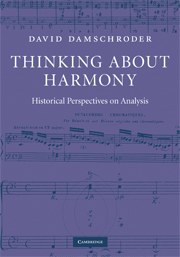Book contents
- Frontmatter
- Contents
- Preface
- 1 Chord identification
- 2 Chordal embellishment
- 3 Parallel and sequential progressions
- 4 Harmonic progression
- 5 Chordal hierarchy
- 6 Modulation to closely related keys
- 7 Chromatic chords: diminished/augmented
- 8 Chromatic chords: major and minor
- Epilogue
- Biographies of music theorists
- Notes and references
- Select bibliography of secondary literature
- Index
3 - Parallel and sequential progressions
Published online by Cambridge University Press: 02 November 2009
- Frontmatter
- Contents
- Preface
- 1 Chord identification
- 2 Chordal embellishment
- 3 Parallel and sequential progressions
- 4 Harmonic progression
- 5 Chordal hierarchy
- 6 Modulation to closely related keys
- 7 Chromatic chords: diminished/augmented
- 8 Chromatic chords: major and minor
- Epilogue
- Biographies of music theorists
- Notes and references
- Select bibliography of secondary literature
- Index
Summary
Parallel motion in thirds or sixths
Strategies for determining chordal roots, symbols for indicating a chord's position within a key or function within a progression, and procedures for segregating embellishing pitches from harmonic chord members are all important components of the analytical process. Yet these techniques do not tell us much about how and why one chord follows another. In fact, they may inject a bias into our analytical deliberations, for they were developed with certain chordal behaviors in mind. The contrasting behaviors characteristic of progressions that we explore in this chapter will not only alert us to some of the lacunae in early analytical procedures, but also expand our vista to include alternative analytical responses triggered by this broader range of chordal motions.
Johann Georg Albrechtsberger, a distinguished composer who counted Beethoven among his pupils in Vienna, launches two fast-paced lines in coordinated ascent, each spanning an octave [3.1a, beat 1 to beat 3]. Their overall effect is to reinforce the tonic chord articulated at the endpoints. Though scale-degree harmonic analysis is not employed in Albrechtersberger's thoroughbass manual, his more progressive German contemporary Portmann places the analytical Arabic numeral 1 (representing tonic in his scale-step theory) below the start of a similar ascent in eighth notes. Observe that the tonic-chord pitches in Albrechtsberger's progression do not always align [3.1b]. Alternative interpretations, with a change of harmony at beat two [3.1c–d], seem forced, at least when sixteenth notes are involved and when articulation slurs are not provided. Gottfried Weber makes similar observations concerning a pair of parallel descending lines [3.1e]. The nonalignment of P and Q within his progression reflects the unevenness of tonic-chord pitch distribution.
- Type
- Chapter
- Information
- Thinking about HarmonyHistorical Perspectives on Analysis, pp. 58 - 84Publisher: Cambridge University PressPrint publication year: 2008



